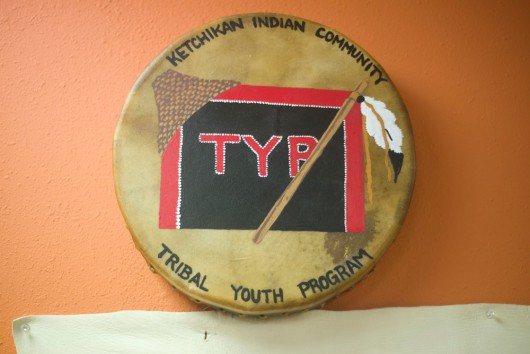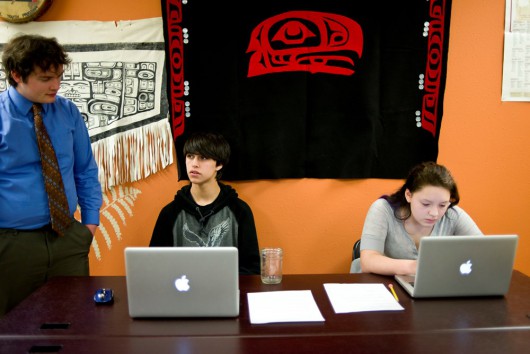Ketchikan Indian Community’s Tribal Scholars is in its fourth year. The grant-funded alternative school recently held an open house inviting the community into a classroom that feels like home.
Walking into the street-level room where Tribal Scholars meets each weekday, it doesn’t look like any other classroom on the island. With a fridge, some couches, bookshelves and art on the walls, it feels like home.
A full classroom has 10 students and two teachers.
“So Canada did have a big interest in Alaska at this point, so for Mounties coming looking for an outlaw, totally reasonable. Your character doesn’t necessarily have to be the outlaw, just know that you got Mounties coming to your door, if you have a door.”
Teacher Tiffany Pickrell explains a creative writing assignment.
“Remember they were kind of the law enforcement here in the area, because it was just a shift between Russia and the U.S. and they didn’t know who was in charge.”
The assignment is based in historical Southeast, which allows teacher Peter Stanton to chime in.
“Port Stewart was the nearest big city, which is Prince Rupert”

Tiffany Pickrell is able to give more attention to her students, because the class is small. (Photo by Samuel Wilson)
Tribal Scholars isn’t divided between classrooms and subject; it all blends together. Students get out of the classroom a lot, too. They’ve taken field trips to the Totem Heritage Center and the beach, where science and math incorporate Native traditions.
Freshman Nayomie Welty likes the lessons she can eat.
“So far in our science class we’ve done recipes for things. We tried moose, limpets, gumboot, sea cucumber, salmon patties and I forgot the first one we tried but it was pretty good.”
She liked sea cucumber more than she expected. “Yeah, it was pretty good. I know how to make it now so that’s good.”
The intertidal food unit was a partnership with University of Alaska Southeast. Tribal Scholars project director Sonya Skan says the partnership allows kids to earn college credit, and gain confidence to pursue a degree after high school.
“They actually go across the street to the classroom. So they don’t just stay here and do it. They’re going across the street, they’re going to college. So it does make a difference, in the sense of ‘Oh I’ve already been there, I feel more comfortable with it.”
Tamara Nunley looks forward to graduating, something she wasn’t sure was going to happen until she transferred to Tribal Scholars mid-way through the year. After graduating, she plans to move to Anchorage and certify as a nursing assistant.
“My dream is to be a pediatric nurse, because I love working with little kids. If the kids don’t work I always have the elderly to fall back on, because I lived at home with both my grandparents, but I just recently lost my grandpa, so now I take care of my grandma. So, I’m a second caretaker at my house and it’s kind of fun. I’m getting to learn a lot more about medicine than I already did.”
Tamara and the other scholars spend their afternoons at Ketchikan High School, which allows them to take elective classes such as French or Spanish.
Their Native languages, though, are part of the Tribal Scholars program.
Note cards with Tlingit words are posted on objects throughout the Tribal Scholars classroom and Pickrell said the language is woven into everyday moments.
“It’s a little bit of a running gag in class, but whenever we high five you have to say ‘kei jin dikee,’ which is high five in Tlingit or ‘weehoishk,’ which is awesome is Tsimshian. To have an integrated class it’s fun.”
Because the program is small, teachers and students have influenced and helped the program evolve. Originally, the program was a class exclusively for kids failing high school.
“We’ve been able to open it up, so it’s not just the kids that are struggling anymore. Now it’s just anyone who wants an alternative to what’s already out there for public school.”
Native students last year in Ketchikan had a higher attendance rate than the district average, which Superintendent Robert Boyle said is an anomaly across the state. He credits Tribal Scholars.
The program is expanding this summer, using the Pacific Ocean as a classroom for a six-day expedition. Skan hopes the program continues to expand and becomes an integral part of the district.
She also hopes the homey atmosphere where music and snacks are encouraged as long as they are not distracting can be a model for other schools looking to prepare tribal youth for post-secondary education and culturally relevant courses.

KIC also operates an after-school program at the Tribal Scholars classroom. The class includes traditional art, culture, language, technology and fun with friends. (Photo by Samuel Wilson)
You can find more information about enrollment here.






